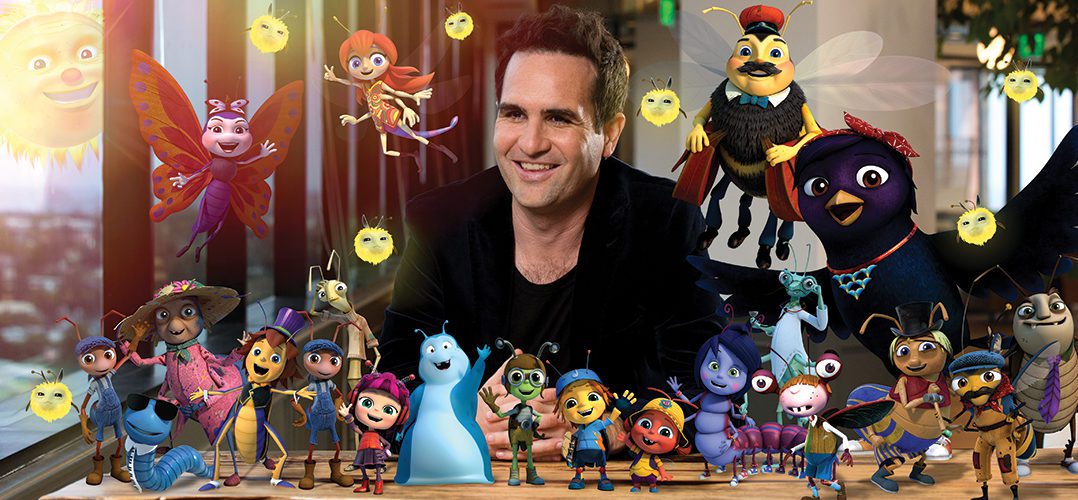A kids’ animation show based on the songs of The Beatles. Great idea, right? Little did Beat Bugs creator Josh Wakely imagine that it would take three years to secure the songs’ rights, not to mention recruiting singers like Eddie Vedder, Sia and Robbie Williams… and making the actual show! Now, this epic undertaking is ready to be be revealed to the world, through a timely deal with Netflix, and to MIPJunior-goers, courtesy of Beyond Distribution. MIPBlog spoke exclusively to Wakely about his labour of musical love…
MIPBlog: Why did you decide to create Beat Bugs?
Josh Wakely: The goal in creating Beat Bugs was to take the music of The Beatles and tell love-filled, moral and timeless lessons to families all around the world. We wanted to bring this extraordinary music to life on screen with heart and imagination, so a new generation of viewers and listeners could learn to appreciate the music and all it has to offer.
> What other kids’ shows provided inspiration?
It’s not a TV show, but I’ve always been a big fan of Toy Story and certainly used that as inspiration. I loved what Pixar was doing and how that particular story explored the complexities and wonders of being a child. I am most interested in shows and films that tell good stories – like Spielberg’s E.T. or The Goonies – that create the kind of rich world anyone can get lost in. That sense of an exciting, imaginary world right beneath your feet is what I’ve tried to create in Beat Bugs.
> Why did you choose The Beatles as opposed to other artists? Did you know beforehand that securing the rights would be challenging?
The Beatles’ music is full of extraordinary melodies and an incredible level of imagination and visual imagery that was so ripe for reinterpretation. The song All You Need is Love is the heart of the show – the notion that there are many challenges one faces as a child, and also as an adult, but they can be solved with love and empathy. This had been a driving idea and a passion for me, and it’s sort of central idea behind this show and our characters.
I was originally wildly naïve about how long it would take to secure the rights. Little did I know it would take three years to obtain the rights to Lennon and McCartney’s Northern Songs catalogue, and once I was finally granted those, it took another three years to bring the world of Beat Bugs to life. There were lots of setbacks during that time. I was working seven days a week, and my wife and I were new parents at the time to our son Ethan, who is now 4. But quitting was just never an option. I knew that the vision I had for each of the characters and the world they live in could not be fully imagined if those songs were not a part of it.
> Once you had the rights, how did you enroll Eddie Vedder, Pink and more to interpret the songs?
While I was pursuing the rights, I lived in a small house with my wife and we had a whiteboard where I listed all the artists who I wanted to be involved in the project – it was like a wish list. We would send handwritten letters asking them to be a part of the show, and one by one as we went through the process, they kept saying yes. I still have a photo of that whiteboard. The music was created with the show’s musical director, Daniel Johns of Silverchair. We would send the tracks to artists to record their versions if we were unable to be in studio with them.
Eddie Vedder was the first artist I reached out to. I grew up listening to him and Pearl Jam. I reached out to him with a letter and an episode, asking him to be a part of the show. It was surreal the day I received a call from him saying he loved the idea and would love to be involved. At first, I thought it was someone playing a joke on me.
I was a huge fan of Sia and always dreamed of her singing Blackbird, so when she reached out and said she would like to sing the song it was serendipitous.
> What do you think convinced Netflix about the show?
I think Netflix appreciated the value of The Beatles’ music and the value of bringing such iconic music to the next generation. The show contextualises iconic music for 4- to 7-year-olds, who have never heard this music before. The imagery within the lyrics of the songs means that the world can be reimagined in a way we haven’t seen on television before, in a way that both the kids and parents can enjoy.
> With kids’ attention increasingly devoted to non-traditional TV, how do you keep it locked on a series? Is the music key there too?
The show is designed to be watched as 11-minute episodes, which makes it easier for kids to pay attention. Both the music and the animation are key in creating a captivating kids’ TV show. There has to be a level of quality to the content, in the style of how Pixar makes films or the calibre of scripted content on HBO. I wanted to apply that quality to children’s entertainment. And then take the very simple life lessons and vibrant, beautiful characters the Beatles describe in their music – for example, « the girl with kaleidoscope eyes” – these are all ingredients to create a show that kids will stick around watching for 11 minutes.
> What’s next after Beat Bugs, and why?
I want to continue creating scripted entertainment that draws from some of the world’s greatest music catalogues, so I’m currently working on another animated children’s project for Netflix that’s based on Motown’s iconic catalogues, and in the style of Beat Bugs, includes legendary classics from Smokey Robinson—who is the show’s executive music producer—Marvin Gaye, Lionel Richie and The Jackson 5. And, I’m working on a live-action drama based on the themes and characters found in Bob Dylan’s music. Plus a few more projects that you will hear about very soon.
Beat Bugs will be brought to MIPJunior 2017 by Beyond Distribution, sponsors of this year’s conference programme. Find out more about this unique show October 14-15 in Cannes!




